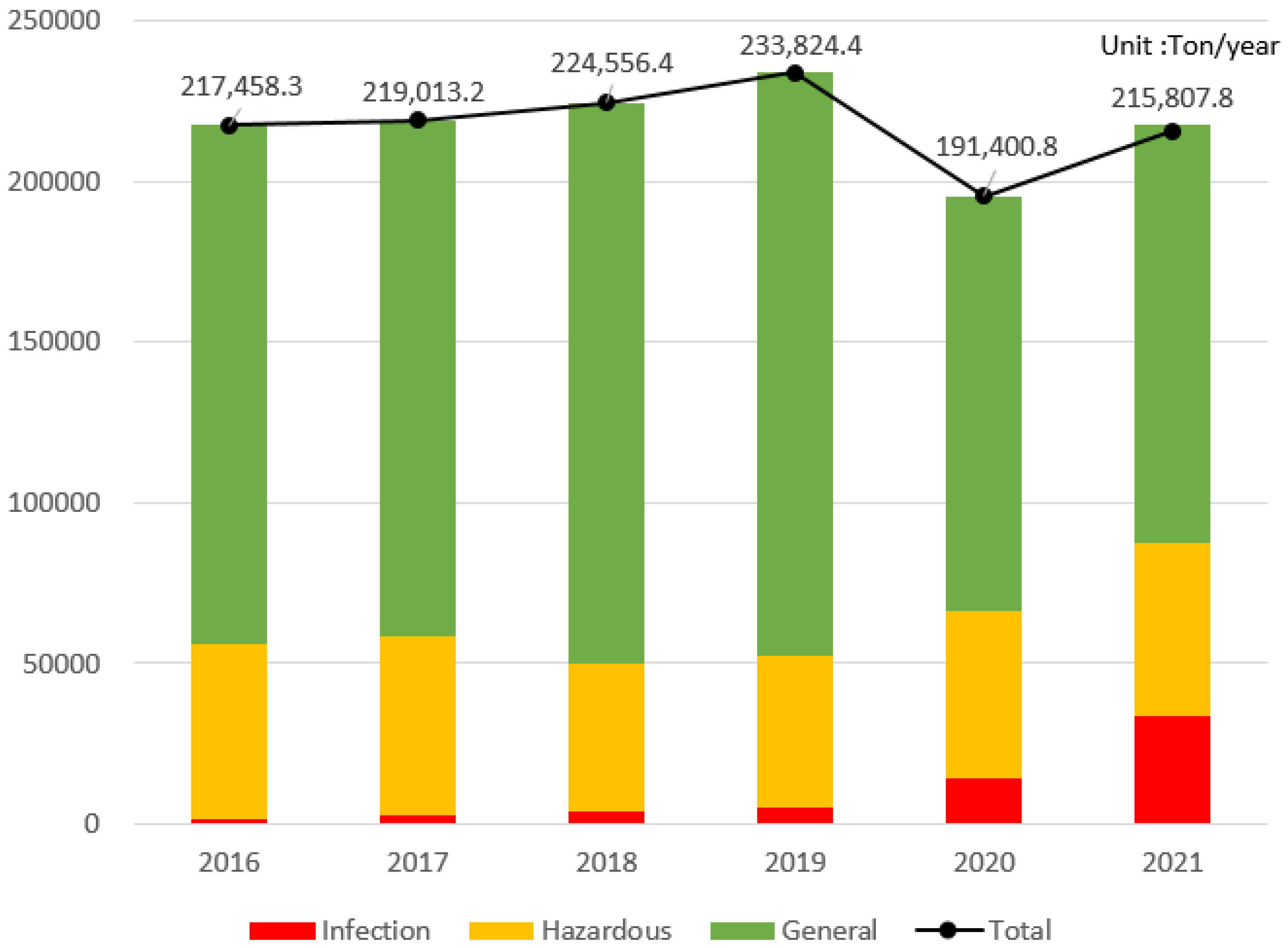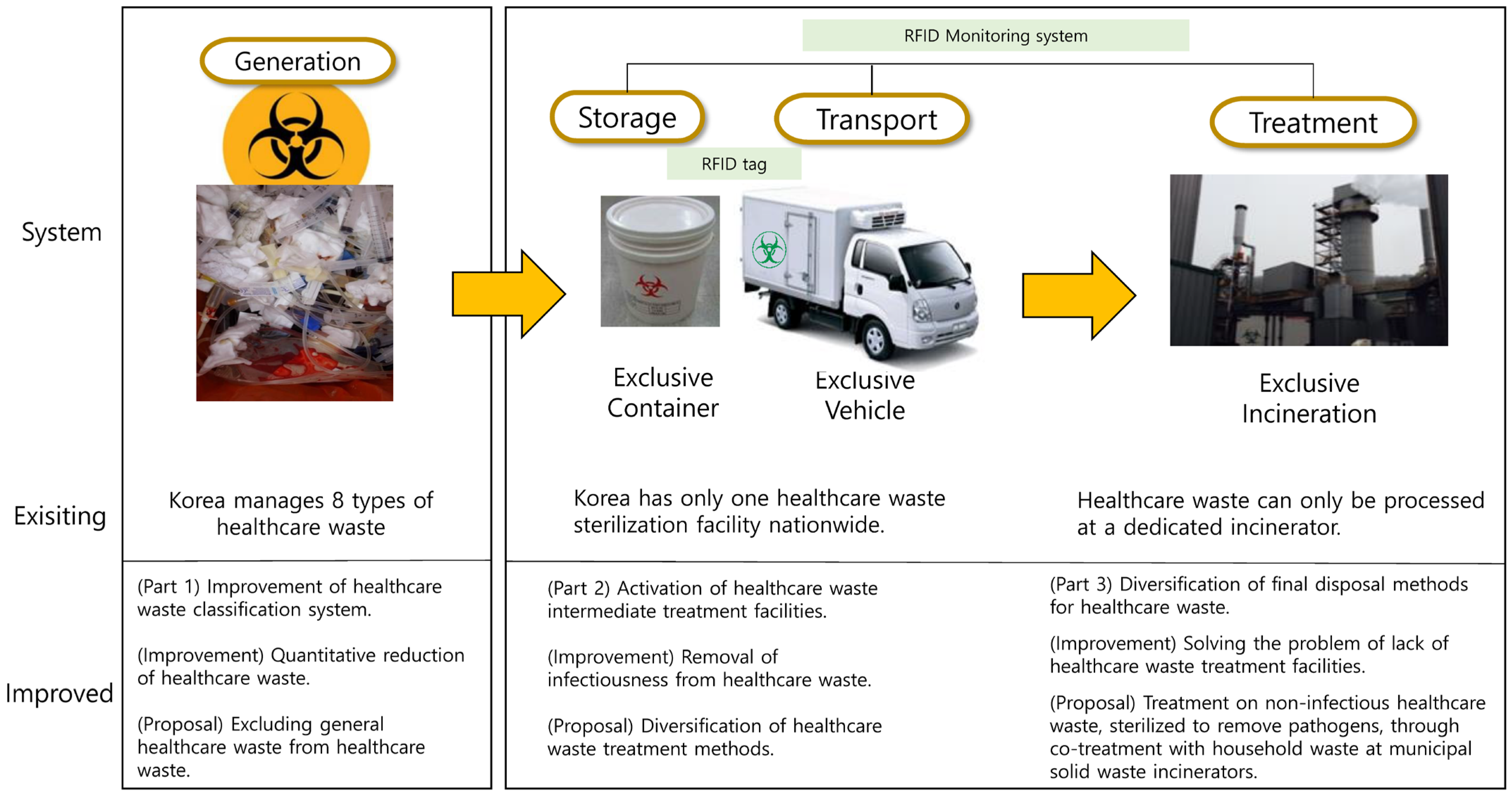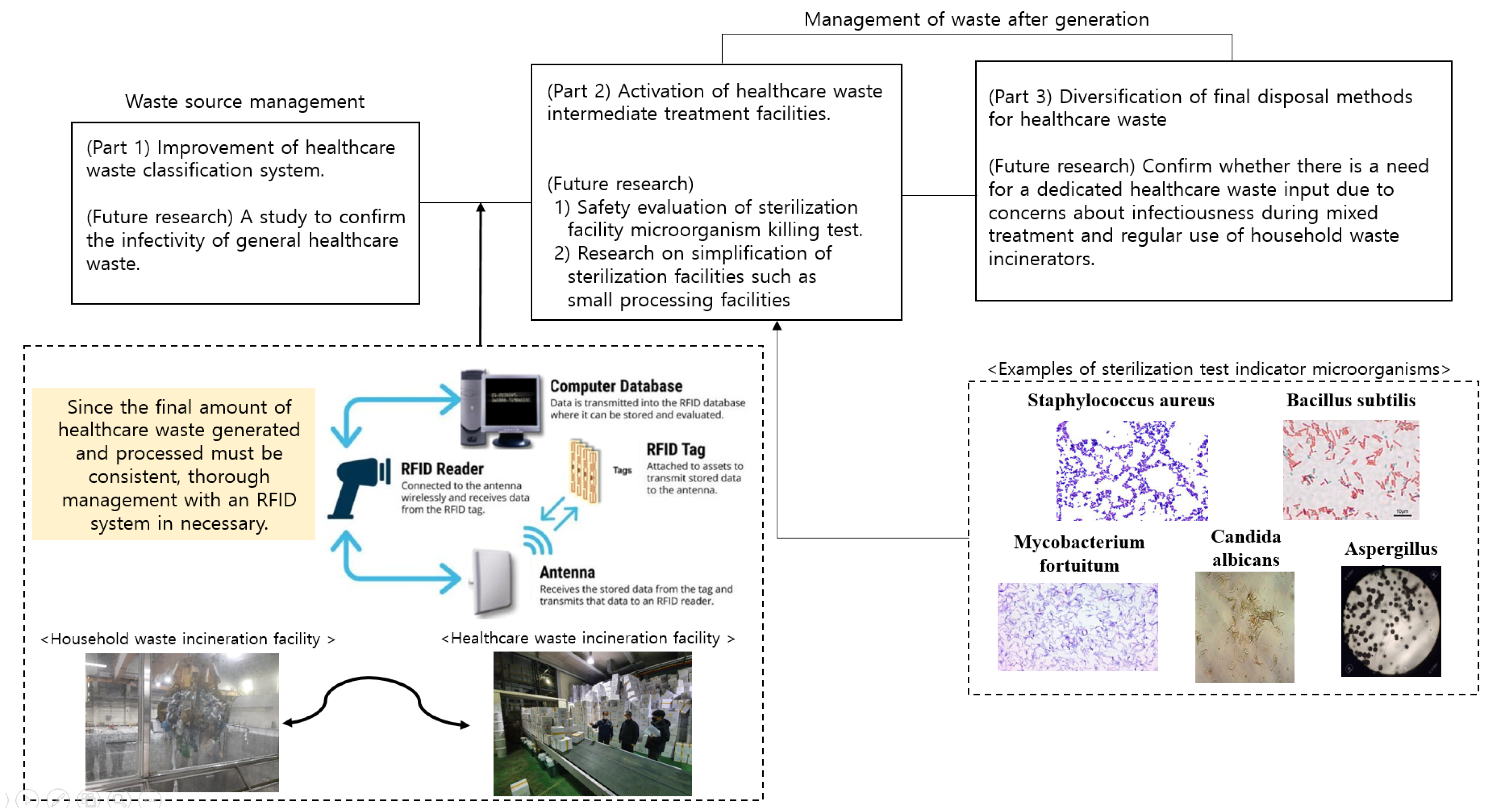An Improved Strategy to Effectively Manage Healthcare Waste after COVID-19 in Republic of Korea
Abstract
1. Introduction
2. Methodology
2.1. Healthcare Waste Generation and Treatment Data
2.2. Confirmed Cases of COVID-19 and the Associated Damage
2.3. Comparison of Domestic and Overseas Healthcare Waste Management Systems
2.4. Management Direction
2.5. Others
3. Results and Discussion
3.1. Generation of Healthcare Waste in Korea
3.2. Treatment of Healthcare Waste in Korea
3.3. Comparison of Healthcare Waste Generation Rates and Treatment before and after the COVID-19 Pandemic in Korea
3.4. Comparisons of Healthcare Waste Management Systems between Foreign Countries and Korea
3.4.1. Classification and Generation of Healthcare Waste
3.4.2. Sterilization Treatments of Healthcare Waste
3.4.3. Healthcare Waste Treatment Systems Components including Incinerators and Transport Vehicles
3.5. Suggestions and Future Challenges for the Healthcare Waste Management System
4. Conclusions
Author Contributions
Funding
Institutional Review Board Statement
Informed Consent Statement
Data Availability Statement
Acknowledgments
Conflicts of Interest
References
- Corona Board. COVID-19 Dashboard. Available online: https://coronaboard.com/ (accessed on 7 April 2022).
- The Korea Herald. Global Maps of COVID-19 Cases. 2020. Available online: http://www.koreaherald.com/coronavirus/index.php#btnTexta (accessed on 7 January 2022).
- Asian Development Bank (ADB). Managing Infectious Medical Waste during the COVID-19 Pandemic. 2020. Available online: https://www.adb.org/publications/managing-medical-waste-covid19 (accessed on 2 December 2021).
- Rhee, S.W. Management of used personal protective equipment and wastes related to COVID-19 in South Korea. Waste Manag. Res. 2020, 38, 820–824. [Google Scholar] [CrossRef] [PubMed]
- Manoj, K.L.; Santosh, K.S. Medical waste management during COVID-19 situation in India: Perspective towards safe environment. Waste Manag. Bull. 2023, 1, 1–3. [Google Scholar]
- Mustafa, A.; Amira, E.; Dilruba, A.; Eldon, R.R. A Review on Medical Waste Managment: Treatment, Recycling, and Disposal Options. Environments 2022, 9, 146. [Google Scholar]
- Jang, Y.C.; Lee, C.; Yoon, O.S.; Kim, H. Medical waste management in Korea. J. Environ. Manag. 2006, 80, 107–115. [Google Scholar] [CrossRef] [PubMed]
- Oh, S.-E.; Ji, K.-H.; Park, S.; Kim, P.; Lee, K.-M. International comparisons of management systems for medical waste and suggestions for future direction of medical waste management system in Korea. J. Environ. Health Sci. 2017, 43, 532–544. [Google Scholar] [CrossRef]
- Residents of Gijang-Gun “Frustrated” by the Plan to Expand Healthcare Waste Incinerators. Financial News, 9 May 2021. Available online: www.fnnews.com/print/202105091938284756 (accessed on 2 December 2021).
- Shin, S.-C.; Byun, H.; Kim, S. A Study on the Application of the Short-Range Principle for Treatment of COVID-19 Medical Waste in Korea. Korean Environment Institute (KEI). 2020. Available online: https://www.kei.re.kr/search/search.jsp (accessed on 11 May 2021).
- ESCAP. The Safe Waste Treatment for COVID-19: Lessons from the Republic of Korea. 2020. Available online: https://www.unescap.org/kp/2020/safe-waste-treatment-covid-19-lessons-republic-korea (accessed on 7 April 2022).
- Ministry of Environment (MOE). 3rd Special Measures for Safety Management of Wastes Related to COVID-19. South Korea, 2020b. Available online: http://eng.me.go.kr/eng/web/board/read.do;jsessionid=fA1DysRKcQJ2ioLZzTmWCSvY.mehome1?paperOffset=150&maxPageItems=10&maxIndexPages=10&searchKey=&searchValue=&menuId=461&orgCd=&boardId=1374270&boardMasterId=522&boardCategoryId=&decorator= (accessed on 14 March 2022).
- The Ministry of Environment Can Handle Too Many COVID-19 Wastes. Financial News, 7 April 2020. Available online: https://www.fnnews.com/news/202004071722241372 (accessed on 25 March 2022).
- “Against Medical Waste Association”... Urging City Council Participation. Nocutnews, 16 January 2024. Available online: https://www.nocutnews.co.kr/news/6079894 (accessed on 15 March 2024).
- Korea Environment Corporation. Allbaro System. 2019. Available online: https://www.allbaro.or.kr/02_wss/wss_ManyPeople.vm (accessed on 6 May 2020).
- Korea Environment Corporation. Designated Waste Occurrence and Treatment, 2014–2019. Available online: https://www.recyclinginfo.or.kr/rrs/stat/envStatDetail.do?menuNo=M13020202&pageIndex=1&bbsId=BBSMSTR_000000000002&s_nttSj=KEC006&nttId=1011&searchBgnDe=&searchEndDe (accessed on 23 April 2020).
- Eurostat. Generation of Waste by Waste Category (Hazardousness and NACE Rev.2 Activity). 2018. Available online: https://ec.europa.eu/eurostat/web/waste/data/database (accessed on 11 March 2022).
- Johns Hopkins University. COVID-19 Data Repository by the Center for System Science and Engineering. 2022. Available online: https://coronavirus.jhu.edu/map.html (accessed on 24 January 2022).
- National Institute of Environmental Research (NIER). Survey on Final Disposal Minimization through Waste Streams Analysis (II); National Institute of Environmental Research (NIER): Incheon, Republic of Korea, 2020. [Google Scholar]
- National Institute of Environmental Research (NIER). Survey on Final Disposal Minimization through Waste Streams Analysis (III); National Institute of Environmental Research (NIER): Incheon, Republic of Korea, 2021. [Google Scholar]
- Oh, S.-E.; Lee, J.; Ahn, H.; Kim, K.-Y.; Park, S.; Ji, K.-H.; Kim, P.; Lee, K.-M. A Study on the Spatial Distribution of Medical Waste Generation and Treatment in Korea. J. Environ. Health Sci. 2015, 41, 449–457. [Google Scholar] [CrossRef][Green Version]
- Basel Convention. Technical Guidelines on the Environmentally Sound Management of Biomedical and Healthcare Wastes (Y1;Y3). 2003. Available online: https://digitallibrary.un.org/record/475506?ln=en (accessed on 7 April 2022).
- California Department of Public Health. 2020. Available online: http://www.cdph.ca.gov (accessed on 22 April 2022).
- Florida Administrative Code. Florida Administrative Act Chapter 64E-16. 2021. Available online: https://www.flrules.org/gateway/ChapterHome.asp?Chapter=64e-16 (accessed on 3 December 2022).
- Government of the United Kingdom. 2020. Available online: http://www.gov.uk (accessed on 3 December 2022).
- Japanese Ministry of the Environment. Waste Management and Public Cleaning Law; Japanese Ministry of the Environment: Tokyo, Japan, 2021. [Google Scholar]
- LAGA (Germany). Guidelines on the Treatment of Healthcare Waste. Ministry of Environment (MOE), 2020a. Waste Management Act (In Korean). 2015. Available online: https://www.law.go.kr/LSW//lsInfoP.do?lsiSeq=228137&ancYd=20210105&ancNo=17851&efYd=20210706&nwJoYnInfo=N&efGubun=Y&chrClsCd=010202&ancYnChk=0#0000\ (accessed on 14 March 2022).
- World Health Organization (WHO). Safe Management of Wastes from Health-Care Activities. 2014. Available online: https://www.who.int/publications-detail-redirect/9789241548564 (accessed on 10 May 2022).
- OECD DATA. Gross Domestic Product (GDP). 2018. Available online: https://data.oecd.org/gdp/gross-domestic-product-gdp.htm (accessed on 13 January 2022).
- Yoon, C.-W.; Kim, M.-J.; Park, Y.-S.; Jeon, T.-W.; Lee, M.-Y. A review of medical waste management systems in the Republic of Korea for hospital and medical waste generated from the COVID-19 pandemic. Sustainability 2022, 14, 3678. [Google Scholar] [CrossRef]
- Hernan, G.; Mazzei, S.S.; Manoj, J.K. Latest insights on technologies for the treatment of solid medical waste: A review. J. Environ. Chem. Eng. 2023, 11, 109309. [Google Scholar]




| Waste Type | Total | Proportion (%) | Infectious Waste | Tissue Logistics Waste | Pathological Waste | Sharp Waste | Bio-Healthcare and Chemical Waste | Blood-Contaminated Waste | Placenta (Recycled) | General Healthcare Waste | |
|---|---|---|---|---|---|---|---|---|---|---|---|
| 2021 | Incineration | 211,916 | 97.3 | 33,322 | 6869 | 14,800 | 5280 | 6748 | 16,416. | 0 | 128,481 |
| Sterilization/pulverization | 2178 | 1.0 | 0 | 0 | 85 | 129 | 0 | 58 | 0 | 1906 | |
| Recycling | 27 | 0.0 | 0 | 0 | 0 | 0 | 0 | 0 | 27 | 0 | |
| Others (wastewater treatment) | 3794 | 1.7 | 0 | 2165 | 420 | 0 | 1 | 1164 | 0 | 44 | |
| 2020 | Incineration | 189,060 | 96.8 | 14,281 | 6425 | 13,345 | 5244 | 6412 | 15,369 | 0 | 127,984 |
| Sterilization/pulverization | 1432 | 0.7 | 0 | 0 | 70 | 135 | 0 | 25 | 0 | 1202 | |
| Recycling | 29 | 0.0 | 0 | 0 | 0 | 0 | 0 | 0 | 29 | 0 | |
| Others (wastewater treatment) | 4831 | 2.5 | 0 | 3201 | 380 | 0 | 0.3 | 1206 | 0 | 44 | |
| 2019 | Incineration | 219,075 | 92.8 | 4891 | 5220 | 10,658 | 2592 | 5658 | 13,323 | 0 | 176,733 |
| Sterilization/pulverization | 1205 | 0.5 | 0 | 0 | 73 | 146 | 0 | 0 | 0 | 986 | |
| Recycling | 0 | 0.0 | 0 | 0 | 0 | 0 | 0 | 0 | 0 | 0 | |
| Others (wastewater treatment) | 15,675 | 6.6 | 0 | 2826 | 402 | 0 | 0 | 12,410 | 0 | 37 | |
| 2018 | Incineration | 221,418 | 93.7 | 3945 | 6631 | 12,534 | 5039 | 6183 | 14,767 | 0 | 172,319 |
| Sterilization/pulverization | 1.171 | 0.0 | 0 | 0 | 58 | 141 | 0 | 0 | 0 | 972 | |
| Recycling | 30 | 0.0 | 0 | 0 | 0 | 0 | 0 | 0 | 30 | 0 | |
| Others (wastewater treatment) | 14,819 | 6.3 | 0 | 2158 | 371 | 0 | 0.1 | 12,241 | 0 | 49 | |
| 2017 | Incineration | 203,402 | 92.8 | 2431 | 5987 | 11,561 | 4573 | 5024 | 13,916 | 0 | 159,910 |
| Sterilization/pulverization | 1061 | 0.5 | 0 | 0 | 53 | 127 | 0 | 0 | 0 | 881 | |
| Recycling | 28 | 0.0 | 0 | 0 | 0 | 0 | 0 | 0 | 28 | 0 | |
| Others (wastewater treatment) | 14,788 | 6.7 | 0 | 2282 | 351 | 0 | 0 | 12,104 | 0 | 51 | |
| 2016 | Incineration | 200,618 | 92.0 | 1744 | 4975 | 11,400 | 4190 | 3795 | 13,301 | 0 | 161,213 |
| Sterilization/pulverization | 959 | 0.4 | 0 | 0 | 46 | 113 | 0 | 0 | 24 | 776 | |
| Recycling | 0 | 0.0 | 0 | 0 | 0 | 0 | 0 | 0 | 0 | 0 | |
| Others (wastewater treatment) | 16,521 | 7.6 | 0 | 2306 | 454 | 0 | 3 | 13,711 | 0 | 47 | |
| Category | Seoul Metropolitan Area | Chungcheong Region | Honam Region | Yeongnam Region | Gangwon/Jeju | Total | |
|---|---|---|---|---|---|---|---|
| Number of incinerators | 3 | 3 | 2 | 5 | 0 | 13 | |
| Year | |||||||
| 2015 to 2017 | 48,018 | 45,263 | 14,060 | 58,187 | 0 | 165,528 | |
| 2018 to 2019 | 57,000 | 43,000 | 15,000 | 73,000 | 0 | 189,000 | |
| 2020 | 54,575 | 53,524 | 30,222 | 76,811 | 0 | 215,131 | |
| 2021 | 54,575 | 63,072 | 30,222 | 88,126 | 0 | 235,995 | |
| Waste Type | 2019 | 2020 | (Rate of Increase Compared to the Previous Year, %) | 2021 | (Rate of Increase COMPARED to the Previous Year, %) |
|---|---|---|---|---|---|
| Total | 233,824.44 | 191,400.79 | △42,423.65 (△18.14) | 215,807.83 | 24,407.04 (12.75) |
| Infectious healthcare waste (Total) | 5319.76 | 14,404.54 | 9084.78 | 35,296.54 | 20,892 |
| Infectious waste | 5319.76 | 8616.85 | 3297.09 (61.98) | 11,007.20 | 2390.35 (27.74) |
| COVID-19 waste | - | 5787.69 | 5787.69 | 24,289.34 | 18,501.65 (319.67) |
| Hazardous healthcare waste (Total) | 47,278.78 | 47,130.51 | 1760.15 | 51,238.26 | 4165.97 |
| Tissue logistics waste (excluding the placenta) | 7118.11 | 6440.08 | △678.03 (△9.53) | 6973.51 | 533.43 (8.28) |
| Pathological waste | 12,786.94 | 13,425.89 | 638.95 (5.00) | 14,978.81 | 1552.92 (11.57) |
| Sharp waste | 5424.58 | 5305.35 | △119.23 (△2.20) | 6033.18 | 787.83 (13.72) |
| Bio-healthcare, chemical waste | 6580.96 | 6411.52 | △169.44 (△2.57) | 6804.20 | 362.68 (6.12) |
| Blood-contaminated waste | 15,336.89 | 15,490.38 | 153.49 (1.00) | 16,418.88 | 928.5 (5.99) |
| Placenta (recycled) | 31.30 | 30.29 | △1.01 (△3.23) | 29.68 | △0.61 (△2.01) |
| General healthcare waste | 181,225.90 | 129,892.74 | △51,333.16 (△28.33) | 129,273.03 | △619.71 (△0.48) |
| Category | Korea | USA (California and Florida) | EU | Japan |
|---|---|---|---|---|
| Infectious healthcare waste | All waste generated from healthcare treatment of people quarantined to protect others from infectious diseases | Isolated waste/infectious pathogens and related organism media | Waste whose collection and disposal are subject to special requirements to prevent infection |
|
| Hazardous healthcare waste | (Tissue logistics waste) Parts of the tissues, organs, and bodies of humans or animals; animal carcasses; and blood, pus, and blood products (serum, plasma, and blood products) | Animal waste | Body parts and organs, including blood bags and blood products | - |
| (Pathological waste) Culture media, culture vessels, stored strains, waste test tubes, slides, cover glass, spent media, and gloves used for testing and inspections | Pathological waste | - |
| |
| (Sharp waste) Injection needles, suture needles, surgical blades, acupuncture needles, dental needles, and test instruments with broken glass | Injury waste/unused injury waste | Pointed or sharp objects |
| |
| (Bio-healthcare and chemical waste) Waste from vaccines, anticancer drugs, and chemotherapeutic agents | Anticancer drugs/small amounts of chemically harmful substances | Chemicals/cytotoxic drugs and mitogens consisting of or containing dangerous toxic substances | - | |
| (Blood-contaminated waste) Blood bags and waste generated from hemodialysis; other waste that requires special management due to a blood leak | Blood |
| ||
| General healthcare waste | Cotton wool, bandages, gauze, sanitary pads, disposable syringes, and infusion sets soiled with blood, body fluids, and secretions | Non-hazardous waste | Waste whose collection and disposal are not subject to special requirements to prevent infection | Non-hazardous waste |
| Management of general healthcare waste as healthcare waste | ○ | x | x | x |
| Category | Amount (2018) (Unit: Tons) | Population (2018) (Unit: People) | GDP (2018, USD) (Unit: Million) | |
|---|---|---|---|---|
| Korea | 238,200 | 51,610,000 | 1619,424 | |
| Average | 93,000 | 69,220,000 | 2,918,351 | |
| Four EU countries | Germany | 3263 | 82,910,000 | 3,996,759 |
| France | 55,568 | 67,100,000 | 2,777,535 | |
| Italy | 137,711 | 60,420,000 | 2,073,902 | |
| UK | 176,919 | 66,460,000 | 2,825,208 | |
| Category | Heat Treatment | Chemical Treatment | Other Treatments | |
|---|---|---|---|---|
| Country | ||||
| Korea | Steam, microwave, and dry heat | Not allowed | Not allowed | |
| WHO | Steam, microwave, and dry heat | Disinfectants and alkaline hydrolysis | Radiation, biological, and mechanical treatments | |
| Basel | Steam and dry heat | Chemical agents | Microwave, radiation, and encapsulation | |
| USA | California | Steam | Available under the approval of the department in charge or in case of equivalent performance (Results in the destruction of pathogenic microorganisms) | |
| Florida | Steam | Allowed | Allowed | |
| Japan | Steam and dry heat | Allowed | - | |
| UK | Steam, microwave, and dry heat | Allowed | Direct landfilling is allowed in case of no infectivity | |
Disclaimer/Publisher’s Note: The statements, opinions and data contained in all publications are solely those of the individual author(s) and contributor(s) and not of MDPI and/or the editor(s). MDPI and/or the editor(s) disclaim responsibility for any injury to people or property resulting from any ideas, methods, instructions or products referred to in the content. |
© 2024 by the authors. Licensee MDPI, Basel, Switzerland. This article is an open access article distributed under the terms and conditions of the Creative Commons Attribution (CC BY) license (https://creativecommons.org/licenses/by/4.0/).
Share and Cite
Kim, M.-J.; Park, Y.-S.; Kim, T.; Choi, H.-H.; Yoon, Y.-s.; Jeon, T.-w.; Um, N. An Improved Strategy to Effectively Manage Healthcare Waste after COVID-19 in Republic of Korea. Sustainability 2024, 16, 2696. https://doi.org/10.3390/su16072696
Kim M-J, Park Y-S, Kim T, Choi H-H, Yoon Y-s, Jeon T-w, Um N. An Improved Strategy to Effectively Manage Healthcare Waste after COVID-19 in Republic of Korea. Sustainability. 2024; 16(7):2696. https://doi.org/10.3390/su16072696
Chicago/Turabian StyleKim, Min-Jung, Yoon-Soo Park, Taesung Kim, Hyo-Hyun Choi, Young-sam Yoon, Tae-wan Jeon, and Namil Um. 2024. "An Improved Strategy to Effectively Manage Healthcare Waste after COVID-19 in Republic of Korea" Sustainability 16, no. 7: 2696. https://doi.org/10.3390/su16072696
APA StyleKim, M.-J., Park, Y.-S., Kim, T., Choi, H.-H., Yoon, Y.-s., Jeon, T.-w., & Um, N. (2024). An Improved Strategy to Effectively Manage Healthcare Waste after COVID-19 in Republic of Korea. Sustainability, 16(7), 2696. https://doi.org/10.3390/su16072696








